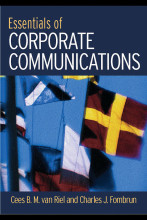Descriptive Analytics I: Nature of Data, Statistical Modeling, and Visualisation - Regression Modelling for Inferential Statistics
6 important questions on Descriptive Analytics I: Nature of Data, Statistical Modeling, and Visualisation - Regression Modelling for Inferential Statistics
What is regression and what statistical purpose does it serve?
Regression is relatively simple statistical technique to model the dependency of a variable (response or output variable) on 1 (or more) explanatory (input) variables.
It can be used for:
It can be used for:
- hypothesis testing (theory building): investigating potential relationships between different variables. It can reveal the strength and directions of relationships between a number of explanatory variables and the respons variable.
- Prediction/forecasting: estimating values of a response variable based on 1 or more explanatory variables. The equation is used to predict.
What are the commonalities and differences between regression and correlation?
Correlation: is not concerned with te relationship between variables. It gives an estimate on the degree of association between the variables?
regression: attempts to describe the dependence of a respons var. on 1 (or more) explanatory vars. Implicit assumption that there is a 1-way causal effect.
regression: attempts to describe the dependence of a respons var. on 1 (or more) explanatory vars. Implicit assumption that there is a 1-way causal effect.
What is OLS? How does OLS determine the linear regression line?
OLS: Ordinary Least Squares: is a method/algorithm to identify the regression line. It leads to the mathematical expression for the estimated value of the regression line.
- Higher grades + faster learning
- Never study anything twice
- 100% sure, 100% understanding
List and describe the main steps to follow in developing a linear regression model?
tbd
What are the most commonly pronounced assumptions for linear regression?
Linearity: linear relationship between vars.
Independence (of errors): the errors of the response variable are uncorrelated of each other.
Normality (of errors): the errors of the response variable are normally distributed
Constant variance (of errors): the errors of the response variable have the same variance. Assumption is invalid if resp.vars. over a wide enough range.
Multicollinearity: the explanatory variables are not correlated.
Independence (of errors): the errors of the response variable are uncorrelated of each other.
Normality (of errors): the errors of the response variable are normally distributed
Constant variance (of errors): the errors of the response variable have the same variance. Assumption is invalid if resp.vars. over a wide enough range.
Multicollinearity: the explanatory variables are not correlated.
What is time series? What are the main forecasting techniques for time series data?
Is a sequence of data points of the variable of interest, measured and represented at successive points in time spaced at uniform time intervals.
naïve forecast: today's forecast is the same as yesterday's actual
ARIMA: very complex: combination of AutoRegressIve and Moving Average patterns
Averaging methods: simple average, moving average, weighted moving average,...
naïve forecast: today's forecast is the same as yesterday's actual
ARIMA: very complex: combination of AutoRegressIve and Moving Average patterns
Averaging methods: simple average, moving average, weighted moving average,...
Try our study magic for free
a PDF, study it super fast
- No sign up, email or credit card needed!
- AI makes unlimited flashcards
- Get unlimited quizzes and tests
- Ask AI anything
Create a notebook
- No sign up, email or credit card needed!
- Have and keep perfect overview
- Make flashcards, notes and mind maps
- Review, test and score!
The question on the page originate from the summary of the following study material:
- A unique study and practice tool
- Never study anything twice again
- Get the grades you hope for
- 100% sure, 100% understanding
Remember faster, study better. Scientifically proven.
































